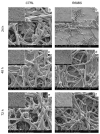Counter-Acting Candida albicans- Staphylococcus aureus Mixed Biofilm on Titanium Implants Using Microbial Biosurfactants
- PMID: 34372023
- PMCID: PMC8348062
- DOI: 10.3390/polym13152420
Counter-Acting Candida albicans- Staphylococcus aureus Mixed Biofilm on Titanium Implants Using Microbial Biosurfactants
Abstract
This study aimed to grow a fungal-bacterial mixed biofilm on medical-grade titanium and assess the ability of the biosurfactant R89 (R89BS) coating to inhibit biofilm formation. Coated titanium discs (TDs) were obtained by physical absorption of R89BS. Candida albicans-Staphylococcus aureus biofilm on TDs was grown in Yeast Nitrogen Base, supplemented with dextrose and fetal bovine serum, renewing growth medium every 24 h and incubating at 37 °C under agitation. The anti-biofilm activity was evaluated by quantifying total biomass, microbial metabolic activity and microbial viability at 24, 48, and 72 h on coated and uncoated TDs. Scanning electron microscopy was used to evaluate biofilm architecture. R89BS cytotoxicity on human primary osteoblasts was assayed on solutions at concentrations from 0 to 200 μg/mL and using eluates from coated TDs. Mixed biofilm was significantly inhibited by R89BS coating, with similar effects on biofilm biomass, cell metabolic activity and cell viability. A biofilm inhibition >90% was observed at 24 h. A lower but significant inhibition was still present at 48 h of incubation. Viability tests on primary osteoblasts showed no cytotoxicity of coated TDs. R89BS coating was effective in reducing C. albicans-S. aureus mixed biofilm on titanium surfaces and is a promising strategy to prevent dental implants microbial colonization.
Keywords: Candida albicans; Staphylococcus aureus; anti-biofilm coating; biosurfactants; cytotoxicity; dental implant; fungal-bacterial biofilm; mixed biofilm; peri-implantitis; scanning electron microscopy; titanium coating.
Conflict of interest statement
The authors declare no conflict of interest. The funders of the study and the companies that provided the titanium discs had no role in the design of the study; in the collection, analyses, or interpretation of data; in the writing of the manuscript, or in the decision to publish the results.
Figures




References
Grants and funding
- Grant for young researchers involved in excellence research projects, ref. n 2017.0340/Fondazione Cassa di Risparmio di Trento e Rovereto
- Call PERIODONTOLOGY / IMPLANT DENTISTRY 2016./SIdP (Italian Society of Periodontology and Implantology)
- Bando Fondazione CRT, Id. 393/Università degli Studi del Piemonte Orientale
LinkOut - more resources
Full Text Sources

